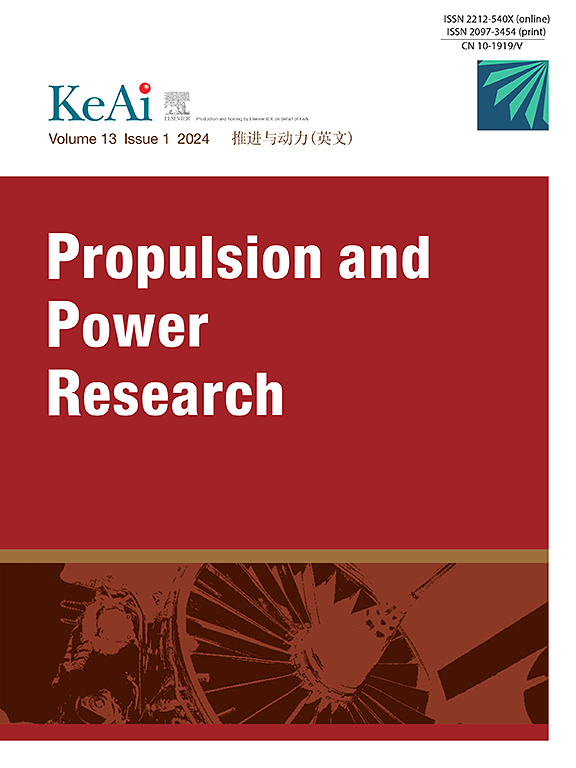超高速入流条件下边界层喷射减阻的数值模拟及性能评价
IF 5.4
2区 工程技术
Q1 ENGINEERING, AEROSPACE
引用次数: 0
摘要
本研究提出了一个定量评估框架来评估边界层喷射(BLI)技术的性能,建立了标准化的指标,用于集成到超燃冲压发动机的性能分析中。采用该评价框架,通过系统的数值研究,对典型燃烧室流入工况下的惰性气体和燃料BLI策略进行了比较评价。主要研究结果表明,与惰性气体(尤其是氢气)相比,燃油喷射具有更好的表面摩擦减少效果,在8马赫以上的条件下,燃油喷射等效比(ER)为0.1,可实现高达600秒的表面摩擦减少性能。氢的优势源于其固有的低密度,加上燃烧引起的对数区域密度降低。这种双重机制抑制了湍流动量输运,并通过大规模的流动重组减弱了表面摩擦。然而,当与没有BLI的反应主流流进行基准测试时,燃油喷射效率显著降低(100秒水平)——边界层燃烧引起的局部密度降低效应被主流热释放减弱,限制了进一步的动量输运抑制,并降低了惰性气体水平的减阻性能。这些结果强调了环境燃烧条件对BLI效率的关键影响,强调了BLI的实施必须优先考虑非反应或弱反应流动环境。提出的标准化指标解决了这种操作依赖性,使BLI优化能够在全引擎设计范例中进行,以防止适得其反的“伪优化”。本文章由计算机程序翻译,如有差异,请以英文原文为准。
Numerical simulation and performance evaluation of skin friction reduction by boundary layer injection under hypervelocity inflow condition
This study proposes a quantitative evaluation framework to assess the performance of boundary layer injection (BLI) technology, establishing standardized metrics for integration into performance analysis of scramjets. We comparatively evaluate inert gas and fuel BLI strategies under typical combustor inflow conditions through systematic numerical investigations employing this evaluation framework. Key findings reveal that fuel injection demonstrates superior skin friction reduction efficacy compared to inert gases, especially hydrogen, achieving skin friction reduction performance up to 600 s at Mach 8+ conditions with an injection equivalence ratio (ER) of 0.1. Hydrogen's advantage arises from its inherently low density, coupled with combustion-induced density reduction in the log-law region. This dual mechanism suppresses turbulent momentum transport and attenuates skin friction through large-scale flow restructuring. However, when benchmarked against reacting mainstream flows without BLI, fuel injection efficacy diminishes significantly (100 s level) — local density reduction effects induced by boundary layer combustion are attenuated by mainstream heat release, limiting further momentum transport suppression and reducing drag reduction performance to inert gas levels. These results underscore the critical influence of ambient combustion conditions on BLI effectiveness, emphasizing that BLI implementation must prioritize non-reacting or weakly reacting flow environments. The proposed standardized metrics address this operational dependency, enabling BLI optimization within full-engine design paradigms to prevent counterproductive “pseudo-optimization."
求助全文
通过发布文献求助,成功后即可免费获取论文全文。
去求助
来源期刊

Propulsion and Power Research
Multiple-
CiteScore
7.50
自引率
5.70%
发文量
30
期刊介绍:
Propulsion and Power Research is a peer reviewed scientific journal in English established in 2012. The Journals publishes high quality original research articles and general reviews in fundamental research aspects of aeronautics/astronautics propulsion and power engineering, including, but not limited to, system, fluid mechanics, heat transfer, combustion, vibration and acoustics, solid mechanics and dynamics, control and so on. The journal serves as a platform for academic exchange by experts, scholars and researchers in these fields.
 求助内容:
求助内容: 应助结果提醒方式:
应助结果提醒方式:


